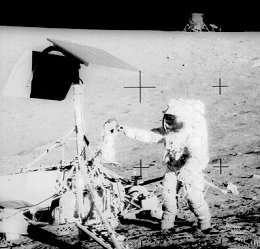Watch Out for Flying Moondust

At Cape Canaveral, not far from the launch pad where the space shuttle lifts off, there's a ragged hole in a chain link fence. Its message: Watch out for flying boulders.
"The powerful exhaust of the shuttle's solid rocket boosters blasts concrete out of the flame trench below the engines," explains physicist Phil Metzger of the Kennedy Space Center (KSC). "On some launches, boulders of concrete up to a half meter wide are blown out as far as a half a kilometer away, traveling fast enough to shatter concrete light poles and punch through chain link fences."
This is no problem as long as people and equipment are kept at a safe distance, easily done. But, Metzger wonders, what if all this was happening on the Moon?
NASA is returning to the Moon in the next decade with plans to establish a durable outpost. There will be habitats, rovers, supply depots and mining equipment. Ships will be coming and going, landing and blasting off--and kicking up debris that might fly a lot farther than boulders at Cape Canaveral. Metzger is researching this problem as part of his work at KSC's Granular Mechanics and Surface Systems Lab.
"Boulders are no concern," he says. Lunar spacecraft will be far less massive than the space shuttle and they won't need such a powerful kick to escape lunar gravity. Movies made by six Apollo spacecraft of their landings and takeoffs showed nothing larger than gravel being rolled away by exhaust gases from the landing rockets.
Instead, Metzger is sweating the really small stuff--"moondust."
Here on Earth, no one pays much heed to dust or sand blasted out by a rocket launch because "atmospheric drag rapidly slows the lightweight particles so they fall harmlessly to the ground a few meters from the blast," he explains. But on the Moon? "There is no atmosphere to slow tiny particles." Small grit can travel enormous distances at high speeds, scouring everything in its path.
This isn't just theory. In November 1969, the Apollo 12 Lunar Module (LM, pronounced "lem") landed about 200 meters from Surveyor 3, a robotic probe that had landed on the Moon in April 1967. The Apollo 12 astronauts walked over to Surveyor 3 to photograph it and to retrieve some pieces for return to Earth. Right away, they noticed that most of Surveyor 3, which at launch was pristine white, had darkened to brown--a result of two-and-a-half years' exposure to extreme lunar conditions.
But the side of Surveyor 3 facing the LM had been sandblasted back to white. In fact, "every bolt, cable, or bracket blocking the spray of fine grit from Apollo 12 left permanent shadows etched onto Surveyor," Metzger says. From examining the returned artifacts, scientists later calculated the sandblasting resulted primarily from finest dust particles only 1 to 10 micrometers (0.00004 to 0.0004 inch) across.
The scoured surfaces were also pocked with hundreds of microscopic impact craters ranging from 30 to 60 micrometers (0.001 to 0.002 inch) across caused by particles of about the same size traveling at high speeds. Moreover, fine grit had been driven into tiny cracks and crevices, including inside Surveyor's camera.
This evidence concerns Metzger because in a future lunar outpost, high-speed fine grit could scour the reflective coating off thermal control blankets, roughen the surfaces of windows and other optics, compromise the surfaces of solar panels, and penetrate connectors or other mechanisms on digging machines or spacesuits, causing friction and even mechanical failure.
Well, why not just land far enough away that speeding sand and dust ceases to be a problem?
Answer: You can run, but you can't hide. Dust particles accelerated by a rocket's exhaust could theoretically travel all the way around the Moon!
Metzger's team has analyzed how the impact craters formed on Surveyor 3 and finds that the particles must have been traveling at least 400 to 1,000 meters per second. "In fact, they may have been traveling as fast as the exhaust gases of the lunar lander—that is, at 1 or 2 kilometers per second."
Particles speeding horizontally at 1.7 kilometers per second will travel literally halfway around the Moon. Boost that speed to 2 kilometers per second, and the projectiles can completely circle the Moon. If no mountains got in the way, grit accelerated by a rocket landing could zip entirely around the Moon "and land back at the rocket's feet," says Metzger.
Now, Metzger is helping other teams of NASA engineers figure out how to mitigate the effects of lunar landings and takeoffs. One strategy might be to locate spaceports in places where mountains and hills serve as natural dust blockers. Artificial berms or other ingenious structures might offer a solution, too.
Says Metzger, "we're working on it."
Source: by Trudy E. Bell, Science@NASA





















